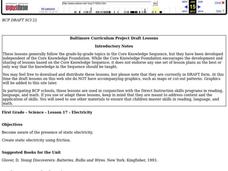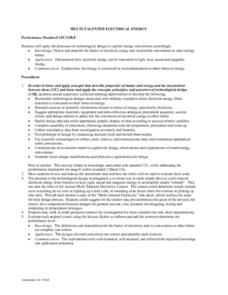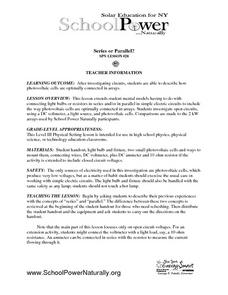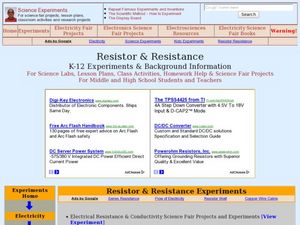Curated OER
Electricity
First graders become aware of the presence of static electricity. They create static electricity using friction.
Curated OER
Electricity
Students watch instructor present demonstrations of the basic principles of static electricity, and then conduct some of their own experiments. In small groups, students build simple circuits, using batteries, to try to light up a light...
Curated OER
Electricity
Students examine basic electrical components. They build a simple electrical circuit which rings a buzzer. They experiment with conducting and nonconducting materials.
Curated OER
Electricity and Magnetism: Are They Related?
Learners explore electricity and magnetism. Through the use of role play, students simulate being a scientist. Experiments are performed during the simulation to discover the relationship between electric current and magnetism. After...
Curated OER
Static Electricity
Young scholars engage in a lesson that is concerned with the concept of static electricity. They conduct an experiment with balloons and make observations of how it works. The data is collected and written down and they define positive,...
Curated OER
Multi-Talented Electrical Energy
Students explore energy conversions by demonstrating the conversion of electrical energy into light, heat, sound, and magnetic energy. Students create a simple device that converts electrical energy from batteries to heat, light, sound...
Curated OER
Electric Field Mapping in 3D
Students create a 3D vector field map of an electric field. In this physics instructional activity, students measure the voltage inside an aquarium with water. They present their findings and map to class..
Curated OER
The Improvement of the Electric Light Bulb
Students study how the first electric light was made and the history behind it. In this electricity lesson students create their own light bulb.
Curated OER
Make an Electric Quiz
In this electric circuits worksheet, students follow the directions to construct an electric quiz board. When the correct answer in one column is matched with the question in another, the light bulb will light up.
Curated OER
Electrical Circuits
Learners explore parallel and series circuits. In this electrical circuit lesson, students investigate the differences between series and parallel circuits. Learners observe the benefits and drawbacks of series and parallel...
Curated OER
Electricity
Students experiment with a series of circuits. In this chemistry instructional activity, students discuss voltage, resistance and current as they flow through an electrical circuit. They work in pairs to solve the questions.
Curated OER
Battery fun
Conduct an experiment with batteries to make a simple circuit. Fifth graders read the provided information, consider the two circuits, and determine which one is complete. An electrically charged experiment suggestion is included. Tip:...
Curated OER
Series or Parallel?
Physics classes that are studying electricity connect photovoltaic cells into both series and parallel circuits. Inquiry and critical thinking come into play as learners try to determine which circuit is more productive. They associate...
Curated OER
Power Problem
Students complete an electricity activity to learn about power outages, insurance, and weather preparation. Students use the worksheet 'Power Problem Work Sheet' and use the 'Global Grocery List Project price list for the U.S.' to...
Curated OER
Simple Atomic Structure
Atomic structure is reviewed with connection to the gain or loss of electrons. The movement of electrons and the resulting behavior is summarized. Practical uses of static electricity is explained, with diagrams of the most common...
Curated OER
Energy Sources
Students explore a variety of sources and types of energy. The difference between energy for a person and energy for an automobile are examined. Efficiency and care for the environment are included in this experience.
Curated OER
Hot and Humid, That's Manu
Elementary and middle schoolers participate in a demonstration of the heat and humidity of the Manu rainforest environment. They watch and discuss a video, calculate the humidity and temperature in the humidified tent, and write a...
Bonneville
Using a Multimeter to Analyze a Solar Circuit: Measuring Current and Voltage—Calculating Power and Resistance
Power to the people who understand electricity. A simple experiment teaches pupils how to set up an electric circuit that includes a solar module and how to measure voltage and current using a multimeter. They calculate power and...
Purdue University
Light – Just Right!
What does it mean to be resistant to electricity? Scholars answer the question in a six-part STEM lesson on electricity. They begin by assessing the conductivity of several different materials and progress to designing their own circuits...
Bonneville
Can Portable PV Charge Vehicles?
Take charge of learning about electric vehicles. Instructors first provide the class with information about PV modules and batteries. Learners then conduct an experiment where they connect PV modules in series and in parallel to...
Science Matters
Electromagnets
Classes are sure to get all wrapped up in an attractive lesson! Young scientists learn how to combine electricity and magnetism as they create electromagnets. They create their own electromagnets and collect data on their strength...
Curated OER
Science Jeopardy - The Earth Sciences
The earth sciences are the focus for this Jeopardy-style review game. Categories include geology, space, scientific investigation, meteorology, and oceanography. Diagrams and pictures are involved with most of the questions, making this...
Consumers Energy
Circuits and the Flow of Electricity Lesson Plan
I think I lost an electron. Are you sure? Yes, I'm positive! Starting with a hands-on demonstration and problem solving activity, young scientists define vocabulary related to circuitry and currents. Then they build their own circuits...
Curated OER
Resistor and Resistance
Young scholars explore electrical resistance through various experiments. In this physics lesson plan, students calculate resistance using a mathematical formula. They explain how colors identify the resistance value of a resistor.

























